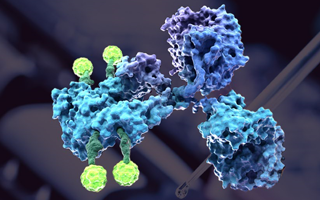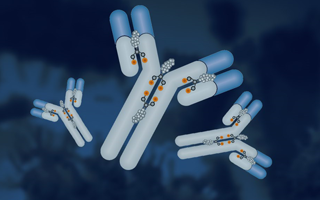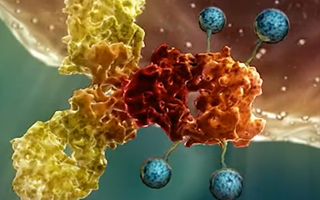Endoplasmic Reticulum Positioning Intrabody Development Service
Creative Biolabs is able to offer ER-targeting intrabody for our global clients through our novel endoplasmic reticulum positioning intrabody development platform. By screening the comprehensive ERRM libraries among multiple model organisms, our scientists can tailor custom Intrabody discovery and development service with the best performance and efficiency to meet your specific requirement.
Endoplasmic Reticulum Positioning
Endoplasmic reticulum (ER) is a eukaryotic organelle composed of an interconnected network of flattened, membrane-enclosed sacs or tube-like cisternae held together by the cytoskeleton, and its membrane is continuous with the outer nuclear membrane and the perinuclear space. Generally, ER presents in almost all eukaryotic cells except for red blood cells and spermatozoa, and functions to synthesize and export proteins and membrane lipids. Particularly, ER can be categorized as follows:
Rough or granular ER (RER) is inlaid with numerous ribosomes on its cytosolic face and especially prominent in hepatocytes.
Smooth ER (SER) lacks inlaid ribosomes and is abundant in mammalian liver and gonad cells. Physiologically, SER functions in the manufacture of lipid and steroid hormones, carbohydrate metabolism, detoxification of natural metabolism products or alcohol and drugs. A special SER, sarcoplasmic reticulum (SR) in myocytes, has the medley of proteins both bound to the membrane and drifting within the lumens, which could store calcium ions and pump out during the muscle fiber contraction.
The ER-targeting protein generally bears a signal peptide (SP) first, which is the first 5-30 amino acids at N-terminus with 8 hydrophobic amino acids at least. The newly synthesized SP will bind to a signal recognition particle (SRP), and the translation pauses once the interaction occurs. Subsequently, the ribosome complex with half synthesized polypeptide approaches the RER translocon to continue the synthesis of the nascent protein into the RER lumen and/or membrane.
As for membrane proteins, there are two major categories of hydrophobic signals (approximately 8 hydrophobic amino acids) used in insertion of membrane crossing domains:
(1) Start transfer sequences, including two types:
- N-terminal signal peptide: it remains in the membrane and is cleaved off once the protein transfer through the membrane.
- Internal start transfer sequence: it locates in the internal polypeptide and is not cleaved after protein transfer.
(2) Stop transfer signal: it is a membrane crossing domain tailed with either an N-terminal signal or a start transfer sequence without cleavage.
Once the translation completes, the nascent protein will be processed by a signal peptidase to removes the signal peptide and keep folding into mature conformation. Now the protein has two options:
- Undergoing secretion pathway: packed into transport vesicles destined for places outside the ER, such as extracellular space.
- Retaining in ER with a retention motif.
ER retention motif (ERRM) is a short peptide of four amino acids manifested as a crucial ER retaining and retrieval signal of the majority of ER resident proteins including many soluble proteins contained in the cisternal lumen and type I transmembrane proteins.
Other Anchoring Modification Options provided by Creative Biolabs
Including the endoplasmic reticulum, Creative Biolabs can also develop specific positioning antibody for a variety of destination, which including but not limited to:
| Extracellular Space | Extracellular Plasma Membrane | Intracellular Plasma Membrane | Cytoplasm |
| Nucleus | Endoplasmic Reticulum | Golgi Apparatus | Mitochondria |
| Chloroplast | Lysosome | Peroxisome | Vacuoles |
At Creative Biolabs, our seasoned scientists are extremely eager to develop more advanced technologies and meet our customers’ demands in developing novel intrabodies, please do not hesitate to inquire us for detailed information.
All of our antibody products and services can only be used for preclinical research studies. Do not use them on humans.
Related Services:
- Extracellular Space Positioning Antibody Development
- Extracellular Plasma Membrane Positioning Antibody Development
- Intracellular Plasma Membrane-Anchored Intrabody Development
- Cytoplasm Positioning Intrabody Development
- Nucleus Positioning Intrabody Development
- Golgi Apparatus Positioning Intrabody Development
- Mitochondria Positioning Intrabody Development
- Chloroplast Positioning Intrabody Development
- Lysosome Positioning Intrabody Development
- Peroxisome Positioning Intrabody Development
- Vacuole Positioning Intrabody Development

Welcome! For price inquiries, please feel free to contact us through the form on the left side. We will get back to you as soon as possible.
Contact us
USA
Tel:
Fax:
Email:
UK
Tel:
Email:
Germany
Tel:
Email:







